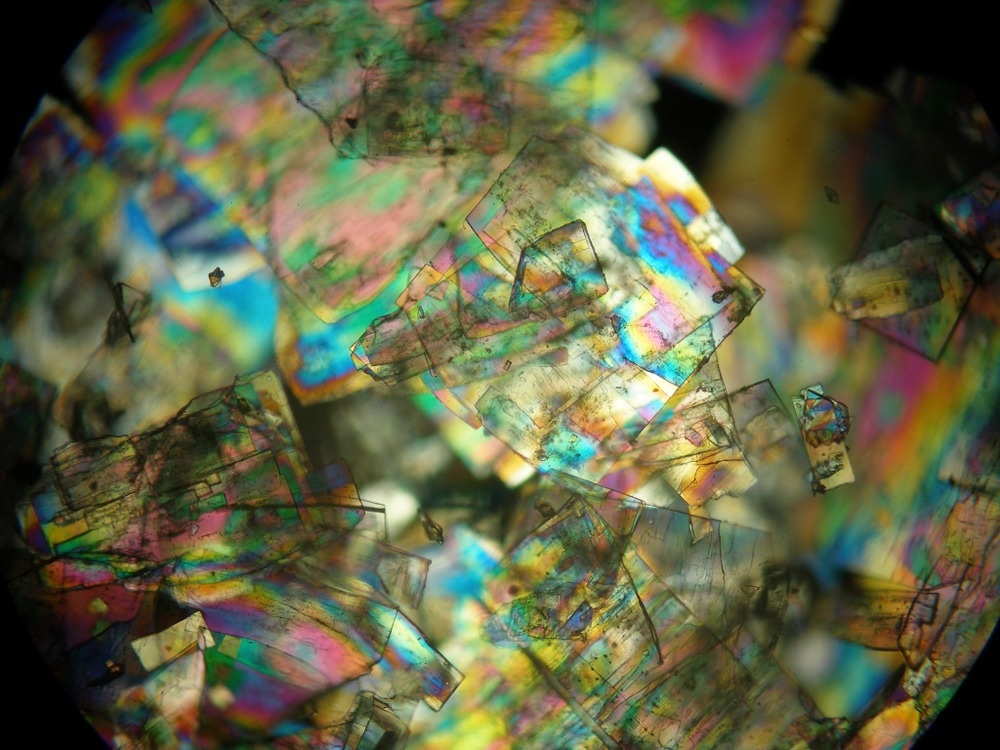A study published in Crystals has reappraised Norman Hartshorne's optical textures from The Microscopy of Liquid Crystals. It proposed that the unique striated pattern of columnar textures is due to the molecular columns producing twisted ropes inside the domains. The study also explains the characteristic multi-pole appearance in the optical textures of columnar formations.

Study: Reappraisal of The Optical Textures of Columnar Phases in Terms of Developable Domain Structures with Relaxed Constraints and A Rationale for The Striated texture. Image Credit: Ad Gr/Shutterstock.com
Herringbone Compression Structures
Herringbone textures can be found in many dimensions, from micrometers in liquid crystalline materials to meters long in a geological layer with external compression. They are caused by either internally generated compressive forces or externally applied stress.
Herringbone texture gives the impression that the meandering pattern is a sine wave, as opposed to a zigzag texture. However, this is not the case for thin mesophase stripes, where the meandering waves are not sinusoidal and are made up of alternating domains.
Significance of Developable Domains
The critical aspect of determining the architectures of developable domains is that splaying columnar structures takes up more energy, whereas bending them is much easier.
This results in textures made up of developable components packed isometrically in a hexagonal array, with the closest spacing of the columns remaining constant throughout the structure.
The cylinder seal used to authenticate official papers is a historical example of the usage of developable domains. It was used to seal documents with the help of wet clay.
Reappraisal of Norman Hartshorne's Optical Textures
Slippage
The developable domain theory implies that molecular columns are smooth and featureless and may glide past each other as a domain grows.
However, some periodic lateral contact between the columns may induce them to assemble in register and prevent accumulated offset strain throughout the stripe. This may be the reason developable domains appear in pairs.
Striations
Lyotropic middle phases, columnar discotics, and chromonic middle phase (M) ribbons exhibit striations that follow the direction field. This is a unique characteristic of optical textures.
Although the striations appear to be spaced evenly, the blocks of color in the optical textures sometimes display rapid and seemingly random shifts. These striations have been observed several times, but no specific explanation for their presence has been provided.
Helical bundles
When the director field is highly curved towards the poles due to dislocations, the inner sections become equidistant helical shaped due to pressure from the outside regions of the director field.
The rotation of the helices can go either clockwise or counterclockwise if the chemical units are non-chiral.
There are several examples of biological polymer systems with multiple helical structures, including double-stranded DNA chains, collagen fibers that are three-stranded helices, and actin fibrils that spontaneously form a double helix.
Multi-pole nucleation
This is another fundamental property of developable domain optical textures that is unexplained. Columnar phases frequently have the appearance of growing from a tiny nucleus and spreading outward when they are generated from the isotropic liquid.
However, the nucleus does not appear as a single sharp point at higher magnification. Instead, it consists of two pairs of locations approximately 1 µm apart, connected by a brief straight line segment. This can be observed in the optical textures of nucleic acid columnar phases.
Helical fibrils
This material exhibits a hexagonal and a nematic columnar mesophase with the well-known developable domain optical textures, making it a columnar mesogen. However, when combined with an acetonitrile-based solvent, it transforms into a gel state in a thermally reversible physical reaction.
New Tentative Hypotheses for the Multi-Nucleated Appearance and the Striated Texture in the Columnar Structures' Optical Textures
The mesophase state's mechanical qualities resembled a sheet of paper, which can be bent in one direction but cannot be curved in another without tearing.
This illustration does not adequately illustrate the concept of developable domains, but it is a step in the right direction. Unfortunately, the importance of the striations that decorate the domains in the visual textures of columnar mesophases was overlooked in previous studies.
Some optical textures previously referred to as focal conics of the discotic and chromonic phases would now be regarded as developable domain structures of the columnar phases.
It is hypothesized that in areas of the director field experiencing severe stress, the strict isometric limitation in these is relaxed. It is also anticipated that the regular alternating of opposing domains in M ribbons reduces column slippage as the mesophase progresses.
Reference
Lydon, J.E. (2022). Reappraisal of The Optical Textures of Columnar Phases in Terms of Developable Domain Structures with Relaxed Constraints and A Rationale for The Striated texture. Crystals. https://www.mdpi.com/2073-4352/12/8/1180
Disclaimer: The views expressed here are those of the author expressed in their private capacity and do not necessarily represent the views of AZoM.com Limited T/A AZoNetwork the owner and operator of this website. This disclaimer forms part of the Terms and conditions of use of this website.